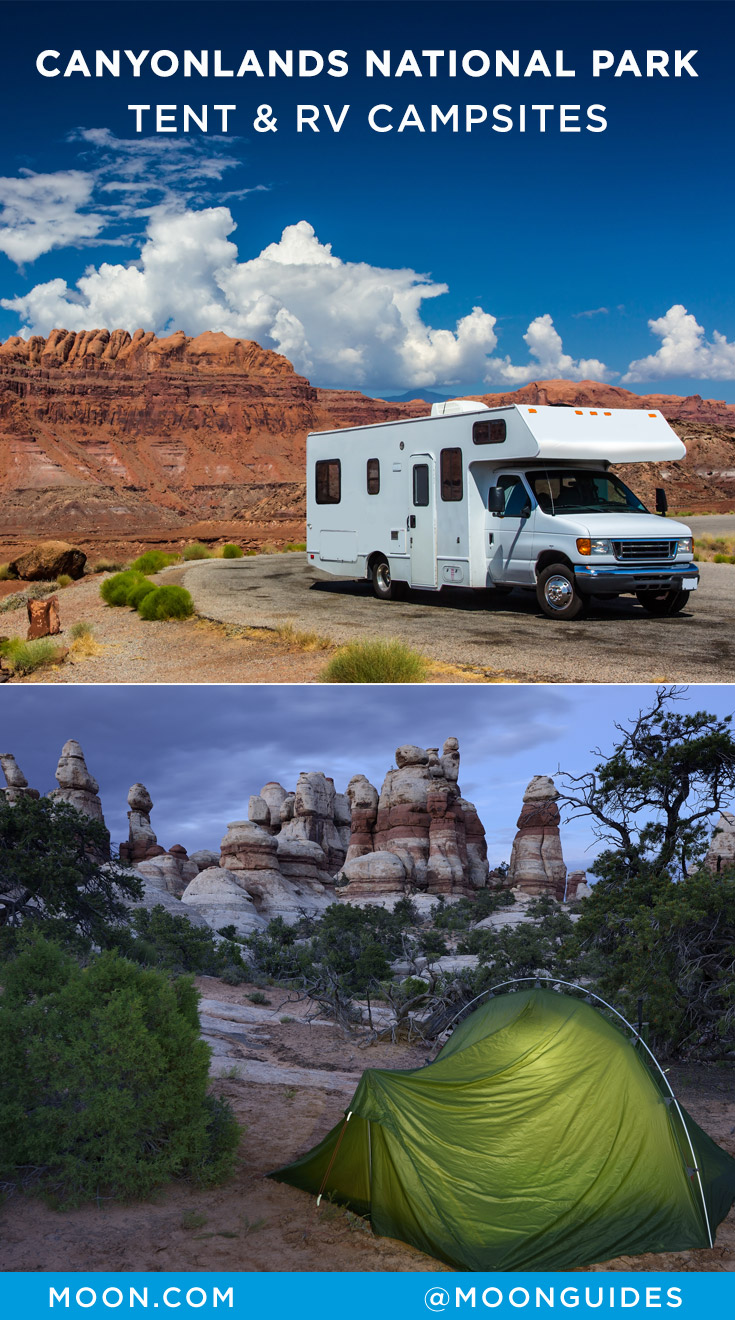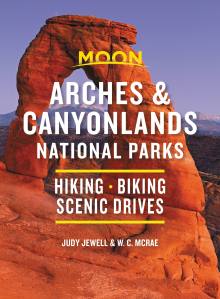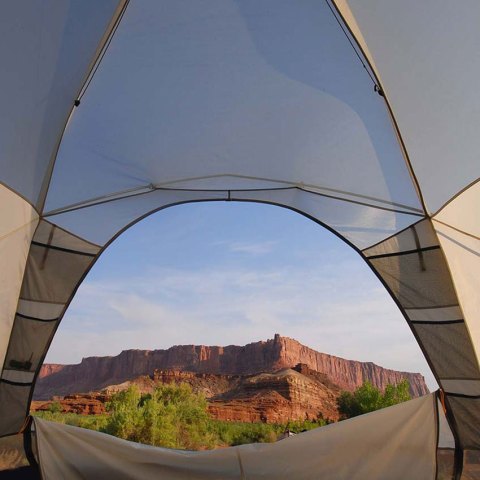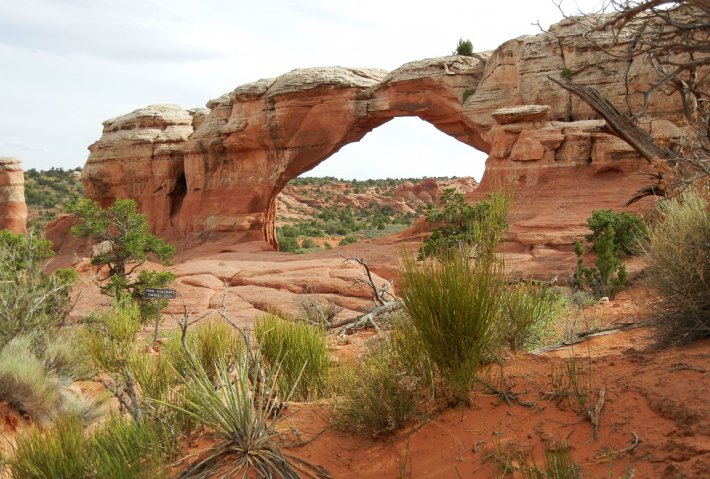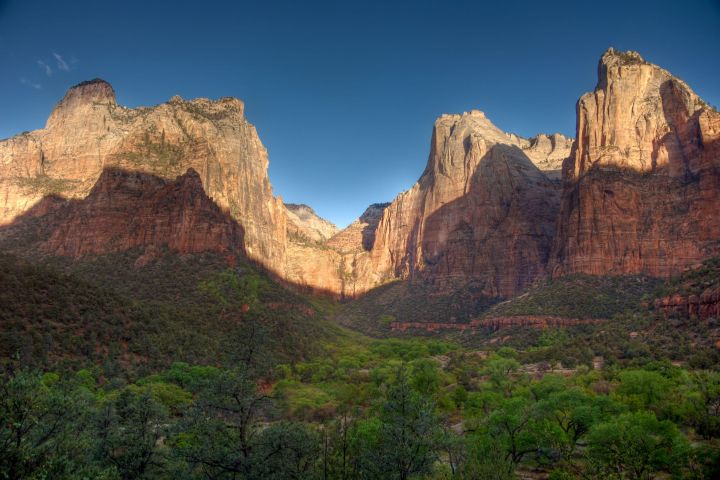Canyonlands National Park Campgrounds
Canyonlands National Park is made up of four sections: the River District, containing the canyons of the Colorado and Green Rivers; the Needles District, with hiking trails and backcountry roads through a standing-rock desert; the Maze District, a remote area filled with geologic curiosities and labyrinthine canyons; and the Island in the Sky District, a flat-topped mesa that overlooks the rest. A separate area, the Horseshoe Canyon Unit, lies to the west and contains a significant cache of prehistoric rock art.

Each district affords great views, spectacular geology, a chance to see wildlife, and endless opportunities to explore. Because most of Canyonlands remains a primitive backcountry park, you won’t find crowds or elaborate park facilities. Of course, the promise of a secluded spot to pitch your tent can make said camping spot difficult to find—and navigating the options a little confusing. Below are some of the tips, tricks, and locations to know before you go.
Front-country camping is allowed only in established campgrounds at Willow Flat (Island in the Sky) and Squaw Flat (Needles), though there are other campsites close by the park. The Maze District offers basic camping areas, though there are no sources of water and you must obtain a backcountry permit. Horseshoe Canyon does not have campgrounds or even allow camping. The River District does not have designated campsites, though this area can be explored via backpacking.
Pets aren’t allowed on trails and must be leashed in Canyonlands National Park campgrounds. No firewood collecting is permitted in the park; backpackers must use gas stoves for cooking. Vehicle and boat campers can bring in firewood but must use grills or fire pans.
Island in the Sky District Camping
There is only one developed campground in the Island in the Sky District. Willow Flat Campground on Murphy Point Road has 12 sites ($15), available on a first-come, first-served basis; sites tend to fill up in all seasons except winter. No water or amenities are available.
Camping is available just outside the park at Dead Horse Point State Park (reservations 800/322-3770, $25, plus $9 reservation fee), which is also very popular, so plan on reserving as far in advance as possible. There are also primitive Bureau of Land Management (BLM) campsites along Highway 313.
Needles District Camping
The Squaw Flat Campground (year-round, reservations for Loop A only Mar. 15-June 30 and Sept. 1-Oct. 31, $20) about six miles from the visitors center, has water and 26 sites, many snuggled under the slickrock. RVs must be less than 28 feet long. Rangers present evening programs (spring-autumn) at the campfire circle on Loop A.
If you can’t find a space at Squaw Flat, a common occurrence in spring and fall, the private campground at Needles Outpost (435/979-4007, mid-Mar.-late Oct., $15 tents or RVs, no hookups, showers $3), just outside the park entrance, is a good alternative.
Nearby BLM land also offers a number of places to camp. A string of sites along Lockhart Basin Road are convenient and inexpensive. Lockhart Basin Road heads north from Highway 211 about five miles east of the entrance to the Needles District. Hamburger Rock Campground (no water, $6) is about one mile up the road. North of Hamburger Rock, camping is dispersed, with many small (no water, free) campsites at turnoffs from the road. Not surprisingly, the road gets rougher the farther north you travel; beyond Indian Creek Falls, it’s best to have 4WD. These campsites are very popular with climbers who are here to scale the walls at Indian Creek.
There are two first-come, first-served campgrounds ($15) in the Canyon Rims Special Recreation Management Area (www.blm.gov). Windwhistle Campground, backed by cliffs to the south, has fine views to the north and a nature trail; follow the main road from U.S. 191 for six miles and turn left. At Hatch Point Campground, in a piñon-juniper woodland, you can enjoy views to the north. Go 24 miles in on the paved and gravel roads toward Anticline Overlook, then turn right and continue for one mile. It’s best to come supplied with water.
The Maze District Camping
Maze District explorers need a backcountry permit ($30) for overnight trips. Note that a backcountry permit in this district is not a reservation. You may have to share a site, especially in the popular spring months. As in the rest of the park, only designated sites can be used for vehicle camping. You don’t need a permit to camp in the adjacent Glen Canyon National Recreation Area (NRA) or on BLM land.
There are no developed sources of water in the Maze District. Hikers can obtain water from springs in some canyons (check with a ranger to find out which are flowing) or from the rivers; purify all water before drinking. The Maze District has nine camping areas (two at Maze Overlook, six at Land of Standing Rocks), each with a 15-person, three-vehicle limit.
Extra care and preparation must be taken for travel in both Glen Canyon NRA and the Maze. Always ask rangers beforehand for current conditions, and be sure to leave an itinerary with someone reliable who can contact the rangers if you’re overdue returning. Unless the rangers know where to look for you in case of breakdown or accident, a rescue could take weeks.
For these reasons, only experienced, prepared travelers will want to take on this rugged land.
By clicking ‘Sign Up,’ I acknowledge that I have read and agree to Hachette Book Group’s Privacy Policy and Terms of Use
See More of Utah's Parks
Pin it for Later
